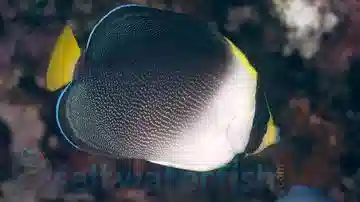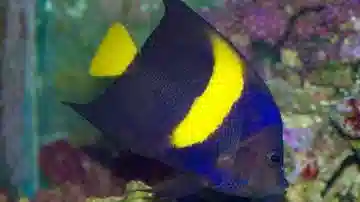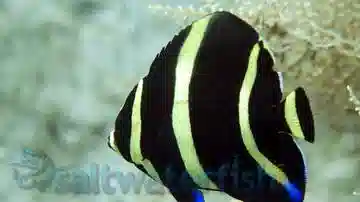Black (Grey) Angelfish
Pomacanthus arcuatus
(1 Reviews)

Black (Grey) Angelfish
Pomacanthus arcuatus
(1 Reviews)
{{ item.name }}
Size: {{ item.extra_field_3 }}
${{ getFormattedPrice(item.saleprice) }} ${{ getFormattedPrice(item.price) }}
To join the waiting list, click here
Free Shipping
With
$199.00
or more in Marine Life.
More details...
Black (Grey) Angelfish Care Facts
| Care Level: | Moderate |
|---|---|
| Temperament: | Semi-Aggressive |
| Diet: | Omnivore |
| Reef Safe: | Yes -With Caution |
| Minimum Tank Size: | 120 gallons |
| Max Size: | 12 inches |
Keeping the Black (Grey) Angelfish (Pomacanthus arcuatus) in Your Saltwater Aquarium
The Black (Grey) Angelfish, scientifically known as Pomacanthus arcuatus, is a striking marine species that has captured the attention of saltwater aquarium enthusiasts. This guide provides comprehensive information for those considering the Black Angelfish as an addition to their aquarium. Covering essential topics such as habitat, reef compatibility, size, lifespan, dietary needs in captivity, aquaculture availability, compatibility with other marine species, sexual dimorphism, coloration changes from juvenile to adult, temperament, tank requirements, and precise water conditions; it serves as a valuable resource. Additionally, we'll explore common names for this species and practical reasons to consider purchasing the Black Angelfish from Saltwaterfish.com.
Black Angelfish Habitat and Natural Range
The Black Angelfish hails from the warm tropical waters of the Indo-Pacific region. It primarily inhabits reef environments, including lagoons and outer reef slopes. In the wild, these angelfish are often found near coral formations, seeking refuge among the crevices and overhangs. To ensure the well-being of your Black Angelfish in captivity, it's crucial to replicate its natural habitat within the aquarium.
Reef Compatibility of Black Angelfish
The Black Angelfish is considered reef-safe. While it generally does not harm stony corals, it may nip at certain soft corals and may indulge in some light substrate rearrangement. Therefore, carefully considering coral selection is essential when introducing this species into a reef aquarium.
Size and Lifespan of Black Angelfish
This angelfish species is known for its substantial size, with adults typically reaching 12 to 15 inches (30 to 38 centimeters). They can live for ten years or more in a well-maintained aquarium with proper care, making them a long-term commitment for dedicated hobbyists.
Diet in Captivity of Black Angelfish
Feeding the Black Angelfish in captivity can be relatively straightforward. Their diet should include:
- High-Quality Marine Pellets: Incorporate high-quality marine pellets into their daily feeding routine to ensure they receive essential nutrients.
- Frozen Foods: Supplement their diet with frozen offerings such as brine shrimp, mysis shrimp, and enriched frozen preparations.
- Vegetable Matter: Like other angelfish, Black Angelfish benefit from occasional offerings of marine algae and vegetable matter, such as seaweed sheets, to mimic their natural herbivorous tendencies.
Aquaculture and Availability of Black Angelfish
Black Angelfish are not commonly available through aquaculture efforts. Most specimens found in the aquarium trade are wild-caught. To ensure the health and well-being of these fish, it's essential to source them from reputable suppliers like Saltwaterfish.com.
Compatibility with Other Fish and Invertebrates of Black Angelfish
When selecting tankmates for your Black Angelfish, remember that they can be territorial and may not tolerate other angelfish of the same genus or similar-looking species. Here are five compatible tankmates to consider:
- Tangs (Acanthurus spp.): Tangs from different genera can often coexist peacefully with Black Angelfish.
- Butterflyfish (Chaetodon spp.): Some species may be compatible, but careful observation is essential to ensure peaceful cohabitation.
- Wrasse (Halichoeres spp.): Many wrasse species are suitable tankmates due to their different body shapes and behaviors.
- Clownfish (Amphiprion spp.): Clownfish are generally peaceful and can share a tank with Black Angelfish.
- Hawkfish (Cirrhitichthys spp.): Hawkfish, known for their perching behavior, typically occupy different tank areas, reducing competition.
Sexual Dimorphism of Black Angelfish
The Black Angelfish does not exhibit significant sexual dimorphism, making it challenging to distinguish between males and females visually.
Juvenile to Adult Coloration Changes of Black Angelfish
Juvenile Black Angelfish displays a striking black coloration with bright yellow vertical bars. As they mature into adults, their coloration transforms into a more subdued grey-to-black hue, often with a hint of blue on their faces and fins. The vibrant yellow bars of their juvenile phase fade away as they transition to adulthood.
Temperament of Black Angelfish
The Black Angelfish is known for its bold and sometimes aggressive nature. It may establish territories within the aquarium and can be territorial toward other angelfish or similarly shaped fish. Therefore, monitoring their interactions and providing sufficient space for each fish to establish its territory is essential.
Tank Requirements for Black Angelfish
To provide the best environment for your Black Angelfish, adhere to these tank requirements:
- Minimum Aquarium Size: A tank with a capacity of at least 125 gallons (473 liters) is recommended for a single Black Angelfish. Larger tanks provide more swimming space and help mitigate territorial disputes.
- Decor and Hiding Places: Incorporate live rock structures, caves, and overhangs to mimic their natural habitat and provide hiding spots.
- Water Conditions: Maintain stable water conditions with the following parameters:
- pH: 8.1 to 8.4
- Salinity: 1.020 to 1.025
- Water Temperature: 74°F to 78°F (23°C to 26°C)
- Water Flow: Moderate to high flow, simulating their natural reef environment.
Common Names of Black Angelfish
The Black Angelfish is also known by the common names Grey Angelfish and Arched Angelfish.
Why People Should Buy the Black Angelfish from Saltwaterfish.com
- Quality Assurance: Saltwaterfish.com is committed to providing healthy and robust marine life. Each Black Angelfish undergoes a rigorous selection process to ensure its optimal health.
- Expert Guidance: Saltwaterfish.com offers valuable resources and expert advice to help you create and maintain the ideal habitat for your Black Angelfish.
- Convenience: With an easy-to-use online platform, Saltwaterfish.com offers a secure and convenient way to purchase marine fish and essential aquarium supplies.
- Sustainability: Choosing Saltwaterfish.com supports responsible sourcing practices and contributes to conservation efforts.
In conclusion, the Black Angelfish (Pomacanthus arcuatus) is a captivating addition to any saltwater aquarium. You can enjoy their remarkable beauty and unique behaviors by adhering to their specific care requirements and providing the right tank conditions. Consider adding the Black Angelfish to your marine setup and benefit from the expertise and quality assurance provided by Saltwaterfish.com.
Very nice reef fish.Black (Grey) Angelfish cleans detritus in the live rock. Doesn't intrude on the reef. Easy keeper.
Reviewed by: Lia Mamorale on Sept. 11, 2021















